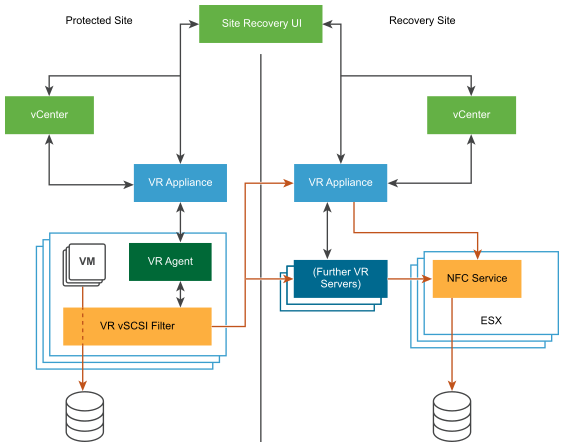With vSphere Replication, you can configure the replication of a virtual machine from a source site to a target site, monitor and manage the status of the replication, and recover the virtual machine at the target site.
When you configure a virtual machine for replication, the vSphere Replication agent sends changed blocks in the virtual machine disks from the source site to the target site. The changed blocks are applied to the copy of the virtual machine. This process occurs independently of the storage layer. vSphere Replication performs an initial full synchronization of the source virtual machine and its replica copy. You can use replication seeds to reduce the network traffic that data transfer generates during the initial full synchronization.
During replication configuration, you can set a recovery point objective (RPO) and enable retention of instances from multiple points in time (MPIT).
As administrator, you can monitor and manage the status of the replication. You can view information for outgoing and incoming replications, local and remote site status, replication issues, and for warnings and errors.
When you manually recover a virtual machine, vSphere Replication creates a copy of the virtual machine connected to the replica disk, but does not connect any of the virtual network cards to port groups. You can review the recovery and status of the replica virtual machine and attach it to the networks. You can recover virtual machines at different points in time, such as the last known consistent state. vSphere Replication presents the retained instances as ordinary virtual machine snapshots to which you can revert the virtual machine.
vSphere Replication stores replication configuration data in its embedded database.
You can replicate a virtual machine between two sites. vSphere Replication is installed on both source and target sites. Only one vSphere Replication appliance is deployed on each vCenter Server. You can deploy additional vSphere Replication Servers.

You can also replicate a virtual machine between datastores at the same vCenter Server. In that topology one vCenter Server manages hosts at the source and at the target. Only one vSphere Replication appliance is deployed on the single vCenter Server. You can add multiple Additional vSphere Replication servers in a single vCenter Server to replicate virtual machines to other clusters.
To perform recovery, the vCenter Server managing the target datastore, the vSphere Replication appliance, and any additional vSphere Replication Servers managing the replication must be up and running.

You can replicate virtual machines to a shared target site.
